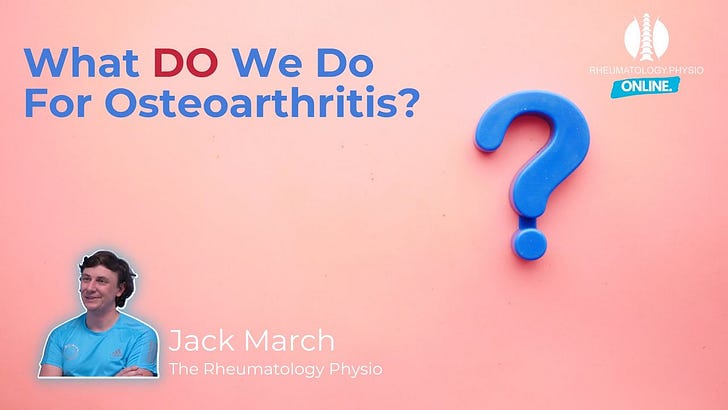Welcome Back Rheumatology Fans,
Its not new that I don’t like the phrase “Wear and Tear”, I have advocated the removal of the rhyming phrase from the healthcare professionals’ verbal repertoire to mixed receptions…
We can do a lot better than this - “Wear and Repair” is at least a less scary 3 word rhyming phrase but it doesn’t explain anything and I don’t think it is any better really. Providing a useful paradigm that aligns with scientific understanding at this time of the mechanisms of Osteoarthritis is important and I am going to stick my head out here with some examples of how I do it.
CAVEAT
Everyone is different, some people want lots of information, others don’t so on and so on and so on. Tailor your communication to the individual please!
Osteoarthritic Mechanisms - Pathophysiology
Right, this is where a large bulk of the issue is and probably where the most controversy is but here we go.
“Osteoarthritis is a net loss of cartilage over time. The cartilage turns over with old tissue being replaced with new. In an Osteoarthritic joint this new cartilage is replaced slower than it is removed, replaced with poorer quality tissue or both. Over time this leads to thinning and lower resistance to force (compression) eventually boney changes will occur in the joint as an attempted protective mechanism as the bone is subject to the forces the cartilage is no longer taking”
Why A Net Loss Though?
“The environment of the joint is less than optimal, this takes a combination of a lot of factors unique to individuals and joints. Joint alignment, previous injury and surgery can increase the loss of cartilage or slow the replacement. General health factors slow the replacement too, increased abdominal fat, smoking, chronic conditions like diabetes and other types of arthritis. Personal factors are also at play, being female, a manual job, low recreational activity levels, high levels of stress also increase the likelihood of the net loss of cartilage.”
What Is The Role Of Visible Damage?
“Severe joint changes are associated with worse outcomes but otherwise the damage to joints seen on xrays is not necessary to experience symptoms of Osteoarthritis. The first changes to the joint are crevasses (loss of smooth surface) of the joint this doesn’t show as thinning on imaging but will affect the ability to absorb load. Equally joint changes don’t guarantee symptoms or mean resolution isn’t possible.”
What Do We Do About It Then?
“A combination of exposing the joint to load to improve its ability to cope and addressing the other modifiable factors to enhance the joint environment. These include weight loss, stress reduction, increasing activity levels, smoking cessation, and dietary improvement depending upon the individual circumstances”
How Do These Things Help?
“Increasing the tolerance of the joint helps it to do more before symptoms are aggravated, think of it like adjusting to a new pair of fancy shoes. Would I wear my recently purchased leather brogues for a 5 mile walk? No, I would start off wearing them about the house for a bit first and build it up.
Increasing the load through the joint and modifying the other factors will do 2 main things, reduce inflammation and improve the density of the cartilage. Typically increased density of cartilage is a good thing improving its ability to absorb load and reducing further loss.”
Further Resources On This Topic
What Actually IS Osteoarthritis?
Hello there Rheumatology Fans, What To Expect In This Article - A Lot Of Meandering! Introductory Thoughts (free) Weight and OA What Do I Think OA Is? Symptoms/Imaging Management Introductory Thoughts According to The World Health Organization, OA is one of the top 10 most disabling diseases It's estimated that 10% of men and 18% of women over the age of 60 have Osteoarthritis. Many many more will have radiological changes associated with Osteoarthritis.
Keep reading with a 7-day free trial
Subscribe to The Rheumatology Physio to keep reading this post and get 7 days of free access to the full post archives.






